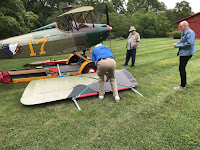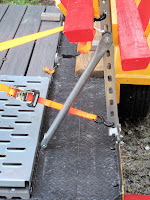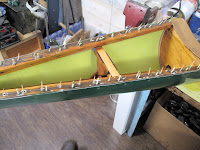Instead we took the plane with us to the Antique Fly-In at Blakesburg, Iowa. The weather was great and we were able to park the plane next to our sales tent (RagBag.com). Lots of people stopped and we had fun talking with them. We were right up front between the Museum and Fly-in headquarters. Maybe we inspired someone to build a Fly Baby.
One of the people who stopped was Kurt Gubert from Ashley, Michigan. In 1977 Kurt phoned my dad and asked if he could stop by to see the plane because he was thinking of building a Biplane Fly Baby. He was so impressed he bough a set of plans and started building. It took him 34 years to finish N6443, lots of other projects. He liked the WWI paint job Dad had done when he built the biplane wings so his is painted like a Sopwith Pup. He also made the gear with bungee cord axles and WWI style wheels. How cool to have both planes on the field at the Fly-in. Kurt lives about 30 miles west of my parents.
Here is the process for loading the plane on the trailer.
With the stands braced upright the wings are loaded on the racks and strapped on. The straps are crossed to provide fore and aft stiffness. The lower wings are on the inside and the uppers on the outside, with the tips toward the front of the trailer.
Once the wings are loaded the stands are laid down.
The fuselage is then aligned with the ramps so it will be centered on the trailer.
With the plane lined up correctly the tail wheel just follows the wooden track to the front of the trailer.
These pictures don't show it, but it's easier to tie down the main landing gear and tail wheel before the wings are stood up.
The wings racks get stood up with the wind brace latched. The top braces are bolted on and the lower ratchet straps added.
The last thing is to strap the ramps to the deck of the trailer.
After the Antique Fly-in we always stop for the week at Galesburg, Illinois and the Stearman Fly-In. This year was their 48 th Fly-In.
We parked the plane on the trailer next to our tent right at show center.
We didn't put the wings on but instead just hung the story banners on the wing for people to read. Again lots of people stopped and talked, good fun.
After the Stearman fly-in we always stop at my parents home near Flushing, Michigan. The plane hadn't been back there since we hauled it to Virginia in 1989.
Mom and Dad were delighted to see the plane that had been so much a part of family.
The whole family was there. Everyone had spent some time helping build it when we were kids.
Brother David and Sister Diane look on as Mom and Dad inspect the new look.
The tail surfaces are clamped to keep from moving. The tail wheel is tied down so it can move fore and aft as the plane bounces but can't come up out of the track. David, Dennis and Debbie getting ready to unfold the wings.
We didn't put the wings on but brothers David and Donald helped move the wings down so everyone could see the plane.
We're back in Virginia. I'm healing from hip surgery and look forward to flying Fly Baby very soon. More good old days yet to be enjoyed.




















































